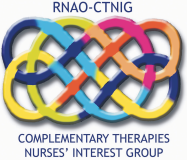Dear CTNIG members,
The CTNIG is looking to create a compendium of complementary therapies (CT) for our website in an effort to provide nurses, other healthcare professionals and the public information about a variety of Complementary Therapies. Each CT would have a short summary including description, background, benefits/effects, process and any links to CT organizations.
We are asking for some assistance from our members who may be interested in helping to create this resource. You could choose which CT you would like to highlight/write up - whether it is one you use personally or professionally, or one you would like to know about. See below for just one example.
Submit your ideas to Andrea Atkinson (CTNIG Membership Chair).
If you are able to contribute some time to our endeavour or have any questions, please contact Andrea Atkinson andrea.n.uher@gmail.com or Darka Neill darka_neill@dalesfordrd.com
Any contribution would be greatly appreciated as many hands make the work light!
Example:
Therapeutic Touch®
What is Therapeutic Touch?
Therapeutic Touch®
is a holistic, evidence-based therapy that incorporates the intentional and compassionate use of universal energy to promote balance and well-being. Therapeutic Touch practitioners are educated to modify a person’s energy field when disease or illness obstructs or depletes their flow of energy. The Therapeutic Touch treatment restores order and harmony to the client’s field. Based on the belief that the body can heal itself, Therapeutic Touch is a method of helping a person to mobilize their own natural healing abilities.
Background
Therapeutic Touch® was introduced in 1972 as a modern healing method, by Dolores Krieger, PhD, RN, and her colleague, Dora Kunz. It is an energy-based healing modality that is a contemporary interpretation of several ancient healing practices.
Three basic assumptions that underlie the practice.
- In a healthy state, life energy flows freely in and out of a person’s energy field in an orderly fashion.
- With disease or injury, energy flow can be obstructed, disordered or depleted.
- Therapeutic Touch practitioners help to restore the flow of energy in the field and move it toward wholeness and health.
Research and clinical experience have shown its effectiveness in:
- promoting a relaxation response
- reducing anxiety and stress
- managing pain
- improving sleep
- facilitating the body's natural healing process
- fostering a sense of wellbeing
Response
As responses to a Therapeutic Touch session vary, there is no "right" way to experience it. Some of those receiving Therapeutic Touch fall asleep during the session. Others may sometimes feel energy moving through their bodies or feel other sensations.
Process
Always individualized, a Therapeutic Touch session usually does not exceed 40 minutes. It can be done with no physical touching, or with light touch on the shoulders, arms and legs. The client remains fully clothed either sitting or lying down.
The practitioner centers themselves, then moves their hands from the client's head to the feet, two to four inches from the body, as they note any differences in the quality of the energy flow.
Following this, the hands are moved in a gentle, rhythmic motion with the intent to redistribute and rebalance the client’s energy field. The Therapeutic Touch session ends with a rest period of 20 minutes or more, during which time the body’s natural healing mechanisms respond to the client’s altered and rebalanced energy flow, and the client’s own healing momentum continues.
For more info, visit: www.therapeutictouchontario.org

